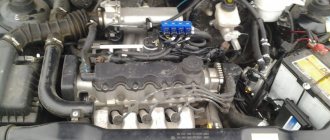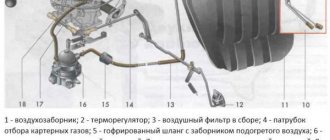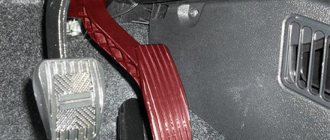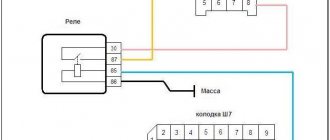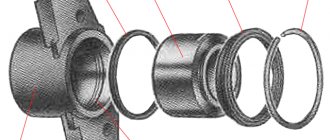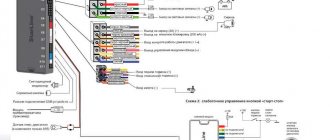Main reasons
When dips appear when you press the pedal, you need to check the following elements.
- Set of high-voltage wires and spark plugs. The latter are criticized more often than other details. If the owner regularly refuels with fuel with harmful additives, over time the electrode becomes overgrown with carbon deposits, as a result of which the spark supply deteriorates. If the source of the problem is a high-voltage wire, you will have to replace it. Better - the whole set at once.
- Injectors. Again, the injection engine does not respond well to clogged fuel injectors. A lean fuel mixture results in the engine not responding to pressing the gas pedal. There are two options - washing in an ultrasonic bath, or completely replacing the kit.
- Throttle valve. If there is a large layer of dirt, it jams, which leads to incorrect operation. The resulting deposit prevents the throttle from functioning normally.
Note! If the cause of the breakdown is a broken wire, it is better to buy the entire set - it is possible that other wires will begin to behave the same way.
When pressed hard
Causes:
- incorrect ignition setting;
- air filter clogged;
- failure of the high pressure fuel pump.
These are the main reasons why a car behaves this way when you press the gas pedal hard. Typically, this behavior is observed for one or two seconds, after which the engine, having reached medium speed, continues to operate without problems.
RPM failure
A drop in speed is manifested by the lack of engine response to the pressed gas pedal. When the driver tries to pick up speed, the car does not react at all, or does it too late. This manifests itself as follows:
- A short dip lasting 3-5 seconds. But this is enough to create a dangerous situation on the road.
- Prolonged lack of response. Up to ten seconds, sometimes more. The car has every chance of stalling.
- Jerks with jerking. Duration - about two seconds.
- Numerous consecutive jerks. The engine operates differently when the gas pedal is in one position.
- A series of deep failures. The car is shaking seriously.
Injector
To determine the causes of failure when pressing the gas pedal in the injector, special diagnostic equipment is used. In most cases, improper operation occurs due to a faulty throttle position sensor. First it checks:
- fine filter clogging level;
- stability of the fuel pump;
- cleanliness of the mesh filter on the intake;
- pressure level inside the fuel rail. Range – 2.8-3.2 bar;
- condition of fuel supply and mixture formation sensors;
- number of errors in the ECU memory;
- condition of the injectors.
Assessment of the condition of the throttle valve, control unit and injector set is carried out only in the service src=»https://nahybride.ru/wp-content/uploads/2019/09/inzhektor.jpg» class=»aligncenter» width=»700″ height ="400″[/img]
Note!
If there are no obvious reasons, you will have to check the ignition system.
How to fix overclocking failures
- Check the ignition wires and coils. When a breakdown occurs, the spark plug wires spark and glow in the dark. The engine shakes and jerks. This happens due to age, poor quality parts or poor contact with the spark plugs. The malfunction may be related to the engine temperature. The interwinding resistance of the coils and the thermal operating conditions change together, which is why a gasoline car jerks during acceleration. If you have a diesel engine, jerks during acceleration are definitely not related to the operation of the coils, they are not there.
- Inspect the spark plugs. Poor contact with the wires, heavy carbon deposits, too lean or rich fuel mixture disable them. Unscrew and check each spark plug as in our article “Diagnostics of internal combustion engine operation using spark plugs,” where we gave examples of faulty spark plugs.
- Check the fuel, oil and air filters. Over time, they become clogged, which leads to deterioration in dynamics, increased fuel consumption and periodic failures. You can replace them yourself; they are inexpensive and easy to install.
If the tips above did not help, only diagnostics will solve the reason for this behavior of the gas pedal. Incorrect operation of systems, errors, composition of the fuel mixture - the diagnostician will name a specific malfunction.
Even if the engine is working properly, the car may move jerkily when accelerating. Motors that meet environmental standards Euro-4 and higher have this unpleasant property. The point is the reaction of the electronic throttle to pressing the gas pedal. It is nonlinear for the first 3-4 centimeters of travel. Because of this, failure may occur during overclocking.
Chip tuning to Euro-2 or Euro-0 standards improves the response of the gas pedal and solves the problem. ECU firmware has a number of other advantages:
- Improves overall dynamics, idle performance and traction at low speeds;
- The car does not stall when the air conditioning is on;
- Gear shifts smoother;
- Fuel consumption is reduced while maintaining driving style.
What are failures?
Failure when pressing the gas pedal lies in the improper reaction of the engine to this. Thus, when trying to accelerate, the engine does not gain the required speed .
This leads to a drop in speed. It manifests itself with gradual and sudden acceleration. Dips appear when you press the gas pedal in different ways:
- Short-term failures. There is no response to pressing for a couple of seconds.
- Lingering failures. The engine loses speed for 4 to 10 seconds, and it is possible that the car will stall.
- Jerks. Laps up to 1 or 2 seconds. The car seems to be “twitching”.
- A series of jerks. The engine either increases speed or slows down, although the pedal is in the same position.
- The car jerks. Consists of a series of protracted failures.
Physical aspect of occurrence
It is a mistake to think that the problem is sudden.
It all starts with short sharp decreases in engine power, lasting no more than 3 seconds. If the driver does not take any response measures, the duration of the dips increases to 10 seconds. The result of the development of a technical malfunction is a series of jerks or failures. After this, the car will have to be left at the service station for a long time. Regardless of the age of the vehicle, the causes of failure are the following: clogging of the fuel system due to the use of low-quality fuel or lubricants, breakdown of the ignition system, engine malfunction, breakdown of the carburetor or its individual part.
From a technical point of view, a decrease in the dynamic characteristics of the engine due to failure occurs when the fuel mixture is too or insufficiently enriched. As soon as it appears in the engine cylinders at the moment you press the gas pedal, the heart of the car experiences increased loads. The following signs will tell the driver about this:
- Minimum dip - duration ranges from 1 to 2 seconds. It occurs even when you gently press the gas pedal or when you start moving. In the future, acceleration and maintaining high speeds occurs without problems. The reason lies in the accelerator pump of the carburetor or in the first chamber of the transition system.
- A series of slight jerks - the vehicle jerks several times when the gas pedal is pressed, with or without a subsequent stop. Most often the problem occurs at low and medium speeds. As soon as the driver presses the gas pedal hard, the problem disappears. This can be caused by oxygen leakage from the carburetor, a critical decrease in the fuel level in the float chamber, or clogged emulsion channels or fuel nozzle.
- A series of dips, or rocking, is when the driver notices unstable engine operation under increased and decreased loads. A malfunction occurs due to incomplete opening of the throttle valve in chamber II, a failure of the fuel supply cycle to the carburetor, clogging of the fuel channels or nozzle, or less often due to the ingestion of air by the carburetor.
What does failure mean?
Failure is nothing more than an interruption in the operation of the power unit. The latter simply reacts untimely to pressing the pedal. Let's say the driver needs to quickly accelerate to perform a maneuver, but the engine does not gain speed.
An interruption is always accompanied by a loss of speed, in some cases up to a complete stop of the machine. It should be understood that dips appear in any case: at low, medium and high speeds, during slow or fast acceleration, etc.
Why are the injectors failing?
On injection internal combustion engines, the cause of failure is often hidden in fuel supply problems. After pressing the accelerator pedal, the pilot of the car gives the order to increase the dose of fuel, but the electronics understand this in their own way.
The reason for the appearance of failures in the injection system can be a clogged FTO (filter). Because of this, gasoline is supplied to the fuel rail in small quantities, which ultimately leads to malfunctions of the power unit. Therefore, it is important to check it, without also losing sight of the other filter - located inside the submersible pump. This is a mesh that traps large particles of litter.
Dips and uneven engine operation on the VAZ-2114
There is a drop in VAZ speed when the driver presses the gas pedal. From a technical point of view, the malfunction occurs in any mode of operation of the iron horse. The main symptom of the problem is a decrease in the dynamic characteristics of the engine up to a complete stop. According to their structure, dips are divided into the following categories: short, deep, jerk, twitch, and a series of dips - swinging.
Physical aspect of occurrence
It is a mistake to think that the problem is sudden. It all starts with short sharp decreases in engine power, lasting no more than 3 seconds. If the driver does not take any response measures, the duration of the dips increases to 10 seconds. The result of the development of a technical malfunction is a series of jerks or failures. After this, the car will have to be left at the service station for a long time.
Regardless of the age of the vehicle, the causes of failure are the following: clogging of the fuel system due to the use of low-quality fuel or lubricants, breakdown of the ignition system, engine malfunction, breakdown of the carburetor or its individual part.
From a technical point of view, a decrease in the dynamic characteristics of the engine due to failure occurs when the fuel mixture is too or insufficiently enriched. As soon as it appears in the engine cylinders at the moment you press the gas pedal, the heart of the car experiences increased loads. The following signs will tell the driver about this:
- Minimum dip - duration ranges from 1 to 2 seconds. It occurs even when you gently press the gas pedal or when you start moving. In the future, acceleration and maintaining high speeds occurs without problems. The reason lies in the accelerator pump of the carburetor or in the first chamber of the transition system.
- A series of slight jerks - the vehicle jerks several times when the gas pedal is pressed, with or without a subsequent stop. Most often the problem occurs at low and medium speeds. As soon as the driver presses the gas pedal hard, the problem disappears. This can be caused by oxygen leakage from the carburetor, a critical decrease in the fuel level in the float chamber, or clogged emulsion channels or fuel nozzle.
- A series of dips, or rocking, is when the driver notices unstable engine operation under increased and decreased loads. A malfunction occurs due to incomplete opening of the throttle valve in chamber II, a failure of the fuel supply cycle to the carburetor, clogging of the fuel channels or nozzle, or less often due to the ingestion of air by the carburetor.
Development of technical malfunction and repair
The above signs are more than enough to carry out an urgent technical inspection of the car. If everything is done according to the instructions and quickly, then the duration and cost of the repair will not go beyond reasonable limits. Otherwise, the engine speed continues to decrease. The next stage will be a sharp dip that occurs when you press the gas pedal, even at idle.
Regardless of the speed of the vehicle, the speed decreases and a sudden stop is possible. In this case, the acceleration pump or insufficient fuel in the carburetor float chamber must be blamed. This indicates serious wear of individual elements, so it is necessary to immediately begin to eliminate the failure that has arisen.
First, you should inspect the strainer responsible for cleaning the fuel. It is located at the inlet of the carburetor. As it performs its functional duties, it accumulates many types of pollutants. The technical clearance, responsible for supplying fuel to the system, narrows due to accumulated contamination. The result of the current situation is an increase in fuel starvation of the 2114 system.
In addition to low-quality fuel, the process of filter contamination is accelerated by corrosion in the fuel tank and fuel lines. Problems can be resolved by cleaning with a soft-bristled toothbrush. It would be a good idea to blow out the inside of the filter with a jet of compressed air. After this, you need to visually inspect the hole located under the filter. The repair work will be completed by installing the filter in its rightful place.
You will have to tinker more if you find a dirt plug inside the filter. First, you should immediately check the fuel pump and fuel intake filter. Perhaps the problem lies in the corrosion process in the gas tank. It is recommended to walk through the fuel line system that is becoming clogged. Only after eliminating the root cause can you begin to clean the filter.
Troubleshooting complex problems
The appearance of excess air in the carburetor provokes many problems. The main one is a decrease in the saturation of the fuel mixture due to reaction with oxygen. The end result is that the throttle valve does not open fully, causing the engine to stall. Troubleshooting begins with a visual inspection of the hoses and tubes leading directly to the carburetor:
- Is the fit on the fittings tight?
- are there any signs of breakage or abrasion;
- are there any abrasions;
- Are there clamps everywhere?
- what is their condition?
Statistics show that excess air is sucked in due to wear or loose fitting of the tubes. Less often, it is necessary to blame the seat of the solenoid valve. This causes wear on the seal ring. It is much worse if the problem is caused by depressurization of the ignition timing regulator. If no problems are found at this stage, attention switches to the float chamber.
The first place in terms of frequency of occurrence is occupied by excessive enrichment of the fuel mixture. As it enters the engine, it literally floods the spark plugs. If the fuel mixture is too lean, then every time you press the gas, the driver notices a failure. Literally, the engine experiences severe fuel starvation, leading to accelerated wear of its individual parts.
Lack of maintenance provokes multiple malfunctions
Visual diagnostics are carried out as follows. To begin with, the engine idles for 5-7 minutes. After this, the driver removes the carburetor cover, under which the actual fuel level in the chamber is visible. If it is not enough, then immediately add it to the minimum required level.
If a problem cannot be found in the float chamber, then you need to look for it in the air or fuel jets.
Less commonly, the reason lies in emulsion wells.
To eliminate the problem, remove the carburetor cover and do the following:
- remove the fuel nozzle;
- remove the air jet;
- clean both parts;
- rinse and be sure to blow with compressed air;
- rinse and clean the emulsion well.
Be sure to check the tightness of the jets. There shouldn't be even the slightest gap. Otherwise, the incoming fuel is mixed with oxygen and then oxidized. As a result, within 2-3 months the spark plugs fail, causing a number of other breakdowns. The technical inspection process is completed by checking the opening of the transition systems for blockages.
Here it is enough to use the power of the eyes. As soot and deposits accumulate, the natural clearance decreases. As a result, the engine does not receive the required amount of fuel. The problem is eliminated by cleaning and blowing with compressed air.
Diagnostics
Checking the injector is faster because there is an electronic control unit. After reading the error codes, the source of the problem can be clearly identified. Carburetor cars do not have this option. Therefore, such a system is diagnosed in its own way.
First you need to check the coherence and correct operation of the fuel system. You have to probe all the places where air leaks may occur. The fuel pump and fuel line are also checked. There should be no deposits or blockages.
If the test results do not reveal any problems, the failure most likely occurs due to the carburetor. This is the main device responsible for mixture formation and intake into the manifold. When the carburetor is working properly, fuel flows evenly without interruption.
Dips when pressing the gas pedal - carburetor
As noted above, the problem occurs in VAZ 2107, 2106, 2109 cars that have a carburetor installed. Mainly problems with the fuel system . It will most likely be clogged. Therefore, to identify the cause, the fuel supply to the carburetor is checked.
As a result of clogging, the operation of the fuel pump decreases, and the carburetor begins to receive less fuel. As a result, the engine starts and idles without problems, but when pressed, failures occur.
Tired of failures?
Contact qualified specialists. With us you can choose a car service that is closer to you and ask for help. They will help you with your problem.
Eliminate
If everything is fine with the fuel system, then the fault must be looked for in the carburetor. It is responsible for dosing the supplied fuel into the air flow. If there are violations, failure occurs. However, first you need to check for air leaks . The carburetor may become loose, allowing air to leak through the gap, making the mixture lean.
The filter mesh must also be checked. It is located in the inlet fitting of the pipeline that goes to the fuel pump. If it is contaminated, then this is a consequence of failures.
Dips when pressing the gas pedal on the carburetor:
Troubleshooting complex problems
The appearance of excess air in the carburetor provokes many problems. The main one is a decrease in the saturation of the fuel mixture due to reaction with oxygen. The end result is that the throttle valve does not open fully, causing the engine to stall. Troubleshooting begins with a visual inspection of the hoses and tubes leading directly to the carburetor:
Statistics show that excess air is sucked in due to wear or loose fitting of the tubes. Less often, it is necessary to blame the seat of the solenoid valve. This causes wear on the seal ring. It is much worse if the problem is caused by depressurization of the ignition timing regulator. If no problems are found at this stage, attention switches to the float chamber.
The first place in terms of frequency of occurrence is occupied by excessive enrichment of the fuel mixture. As it enters the engine, it literally floods the spark plugs. If the fuel mixture is too lean, then every time you press the gas, the driver notices a failure. Literally, the engine experiences severe fuel starvation, leading to accelerated wear of its individual parts.
Check the throttle body
Over time, the throttle body can build up scale around the plate and bore, preventing the throttle body from operating freely.
- Spray carburetor cleaner onto a clean rag.
- Use a rag to remove any accumulated carbon and dirt around the plate and hole.
Burnt, damaged or misaligned contact points on the distributor can cause engine performance problems
How to eliminate gas pedal failure - what not to do yourself
You must understand that even after examining in detail the reasons for failures when pressing the gas pedal
, to carry out self-diagnosis, you need to have certain knowledge of the structure and operating principles of the car. Otherwise, it may result in an additional headache.
If you encounter this problem, you can replace the spark plugs. This procedure will make it possible to postpone contacting a car service, or it will actually help solve the problem.
Good to know! If, when coasting, a hum appears, which is accompanied by vibration, then most likely the propeller shaft bearing needs repair.
If you have the required level of knowledge, you can try to fix this breakdown yourself. It is better to start searching for the problem with spark plugs and explosive wires, and only after that move on to more rare causes. But in the end, you may spend more time, do a lot of unnecessary work, and most likely will not find the reason why the engine does not pick up speed when you press the gas pedal.
We are always ready to help you!
Signs of the reason why the engine is tripping
Engine trouble: what is it, and what are the signs to identify this malfunction? You can understand that the internal combustion engine is malfunctioning by the following signs:
- At idle speed, the engine operates unevenly, jerking periodically;
- The car does not develop the required power when driving;
- The car drives jerkily, when you press the gas pedal, there are gaps in operation;
- The exhaust from the muffler is uneven, with interruptions, pops and shots are possible;
- Fuel consumption increases.
Causes:
There are many reasons why an engine misfires. There are such nuances that even experienced technicians do not immediately determine the nature of the malfunction.
But the most common cylinder failures are the following (starting with the elementary ones):
- The candle does not work;
- The high-voltage wire is broken;
- The ignition coil has failed;
- The control unit is faulty;
- There is an air leak in the intake manifold;
- Exhaust valve burnt out;
- The cylinder head gasket is broken;
- The compression rings on the piston are broken,
- The piston itself has burned out, or the bridge on the piston between the compression rings has burst.
This article is about the VAZ 2114 car, so carburetor malfunctions are not considered, since this device was not installed on the 2114 model. This brand of car has a fuel system with distributed injection (injector), and the answer to the question of why the engine stalls may be hidden in this system.
A little about the Solex carburetor
Initially, VAZ equipped its cars with carburetors of the Weber family. These carburetors were completely mechanized. They lacked any electrical wiring and were not very reliable. Practically, they constantly needed attention, since the main struggle of car owners was aimed at returning the engine to idle speed. Only rear-wheel drive cars of the Zhiguli family VAZ 2101, 2103 and 2106 of the early versions were equipped with it.
“Weber” was replaced by “Ozone”, which began to be successfully used on VAZ 2105-07 cars. It was a perfect design, which was equipped with idle economizers and an autonomous system. The idle problem has been resolved. Ozone was also used on Niva cars.
With the advent of the front-wheel drive VAZ 2108 on the assembly line, a perfect design was required, aimed at reducing exhaust toxicity and maximizing fuel economy. This is how Solex was born.
Initially, it was a French design, which was purchased under license and was successfully installed not only on Samaras, but also on Zhigulis. Its design took into account all the mistakes of previous units, and efficiency increased to the limit. A properly tuned mechanism lasts a long time, and maintenance and repairs are cheaper than many modern cars. Unlike the Ozone family, it uses a long rod drive or cable, which significantly softens the accelerator pedal when depressed.
Almost all domestic carburetors are called DAAZ, and an index is written through a dash, the beginning of which corresponds to the car model.
Where to look for the reason
Often the cause of accelerator pedal dips is a drop in pressure in the fuel rail. For an injection car, the pressure in the ramp is considered normal at 2.8-3.2 Bar.
It is imperative to check the functionality of the sensors involved in the process of mixture formation and fuel supply to the cylinders, namely the throttle position sensor (TPS) and the crankshaft position sensor (CPS).
Failures in their operation will certainly lead to this problem. It would also be a good idea to check the performance of the injectors.
All these elements can be checked at home; it is enough to have a regular pressure gauge and multimeter on hand. With their help, the pressure in the ramp is first checked, and then the indicated sensors. Injectors are tested on special stands.
Mechanical failures of the gas pedal
A separate category of breakdowns is when, when you press the pedal, the leg feels a very specific dip until it clicks, after which the part does not return to its original position, and the car, paradoxically, does not react to this (neither by cutting, nor by smoothly pressing the pedal again). The pedal fails mechanically for only one reason - the problem is a burst seal (rubber or plastic), or the stop of the cable sheath on the gas drive. Sometimes the cable itself breaks, but mostly you have to change the stops and seals. In winter, failure is caused by freezing of condensate in the cable sheath.
Eliminating such pedal failures is quite possible to do yourself if you know exactly the appearance, position and number of the broken part. The most difficult thing is to change a broken throttle cable, so if you are unsure of your abilities, or simply don’t want to waste time, it’s better to involve specialists. Contact a trusted car service center.
Development of technical malfunction and repair
The above signs are more than enough to carry out an urgent technical inspection of the car. If everything is done according to the instructions and quickly, then the duration and cost of the repair will not go beyond reasonable limits. Otherwise, the engine speed continues to decrease. The next stage will be a sharp dip that occurs when you press the gas pedal, even at idle.
Regardless of the speed of the vehicle, the speed decreases and a sudden stop is possible. In this case, the acceleration pump or insufficient fuel in the carburetor float chamber must be blamed. This indicates serious wear of individual elements, so it is necessary to immediately begin to eliminate the failure that has arisen.
First, you should inspect the strainer responsible for cleaning the fuel. It is located at the inlet of the carburetor. As it performs its functional duties, it accumulates many types of pollutants. The technical clearance, responsible for supplying fuel to the system, narrows due to accumulated contamination. The result of the current situation is an increase in fuel starvation of the 2114 system.
Fuel quality
The use of high-quality gasoline or diesel fuel is the key to long-term engine life and obtaining maximum power indicators from it. But none of the drivers is completely immune from refueling with low-quality fuel, the use of which threatens not only a significant reduction in power indicators, but also the inability to start the engine. Regular use of low-quality gasoline manifests itself in intensive formation of carbon deposits on the cylinders, pistons, catalyst and exhaust manifold, as well as increased wear of the cylinder-piston group.
Insufficient compression
And finally, the most unpleasant malfunction, which leads to a decrease in engine speed and loss of power, is insufficient compression. It is a consequence of wear of the piston group parts or the occurrence (coking) of the piston rings. As a result, the pressure in the combustion chambers decreases, and part of the energy from the combustion of the combustible mixture is simply lost.
Compression is measured using a compression meter. Its normal values, depending on the type of engine, can vary from 10 to 14 kg/cm2. Having discovered such a problem, you should think about a major overhaul of the engine.
Lack of maintenance provokes multiple malfunctions
Visual diagnostics are carried out as follows. To begin with, the engine idles for 5-7 minutes. After this, the driver removes the carburetor cover, under which the actual fuel level in the chamber is visible. If it is not enough, then immediately add it to the minimum required level.
If a problem cannot be found in the float chamber, then you need to look for it in the air or fuel jets.
Less commonly, the reason lies in emulsion wells.
To eliminate the problem, remove the carburetor cover and do the following:
- remove the fuel nozzle;
- remove the air jet;
- clean both parts;
- rinse and be sure to blow with compressed air;
- rinse and clean the emulsion well.
Nature of the malfunction
ATTENTION! A completely simple way to reduce fuel consumption has been found! Don't believe me? An auto mechanic with 15 years of experience also didn’t believe it until he tried it. And now he saves 35,000 rubles a year on gasoline! Read more"
If the engine is losing performance, the first thing you need to do is analyze how it is manifesting itself. For example, the engine stops spinning suddenly or it happens gradually. It will also be a plus to study the secondary symptoms.
Poor engine speed may be a consequence of careless repairs that were carried out recently. Errors were made during assembly, and this is having an effect. In these cases, it will not be difficult to find the cause if you independently inspect the engine components or return the car for service.
On the contrary, if the engine weakens for unknown reasons, then it needs in-depth diagnostics. And breakdowns in such cases are possible in different ways: simple and dangerous, sudden and gradual.
Thus, having learned the nature of the malfunction, we get a clue. At the same time, it is recommended to make a list of symptoms associated with the problem.
